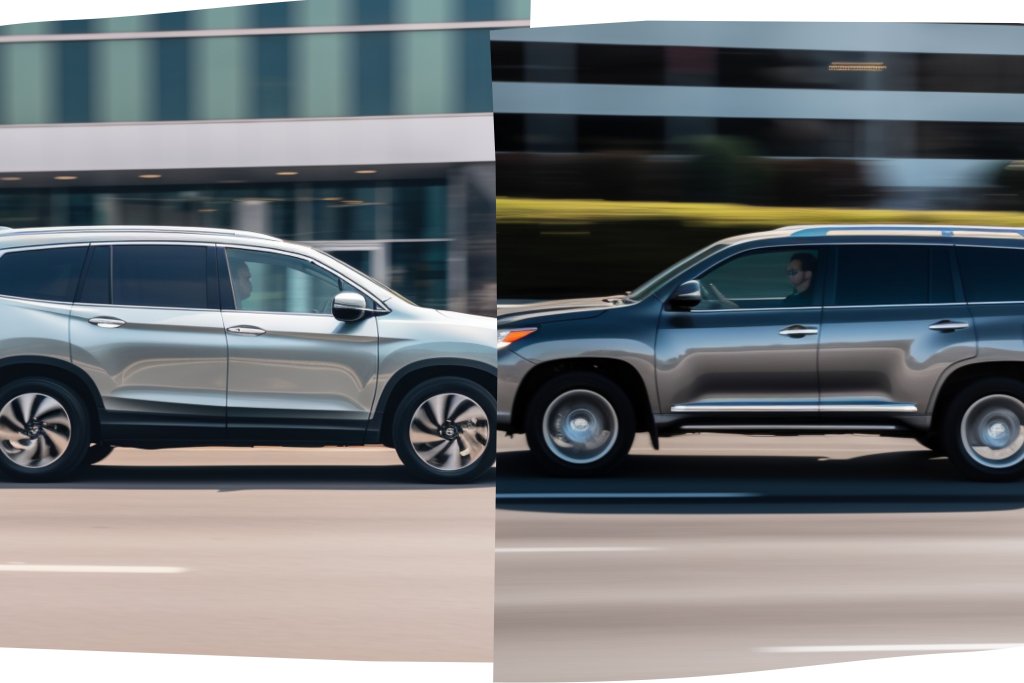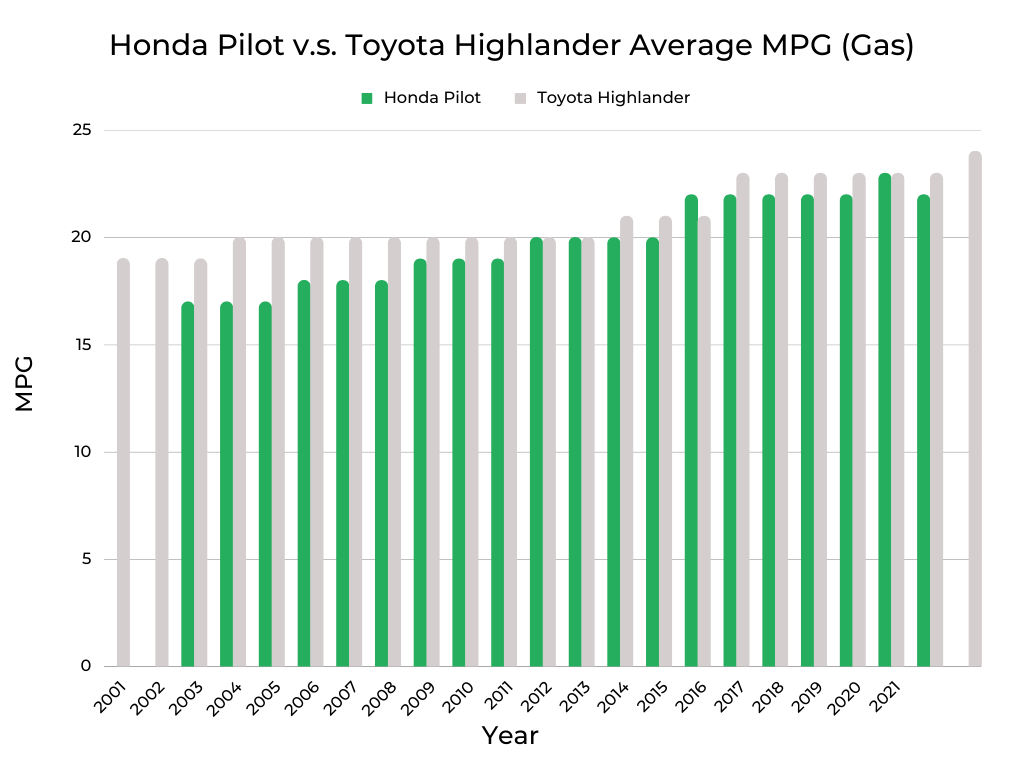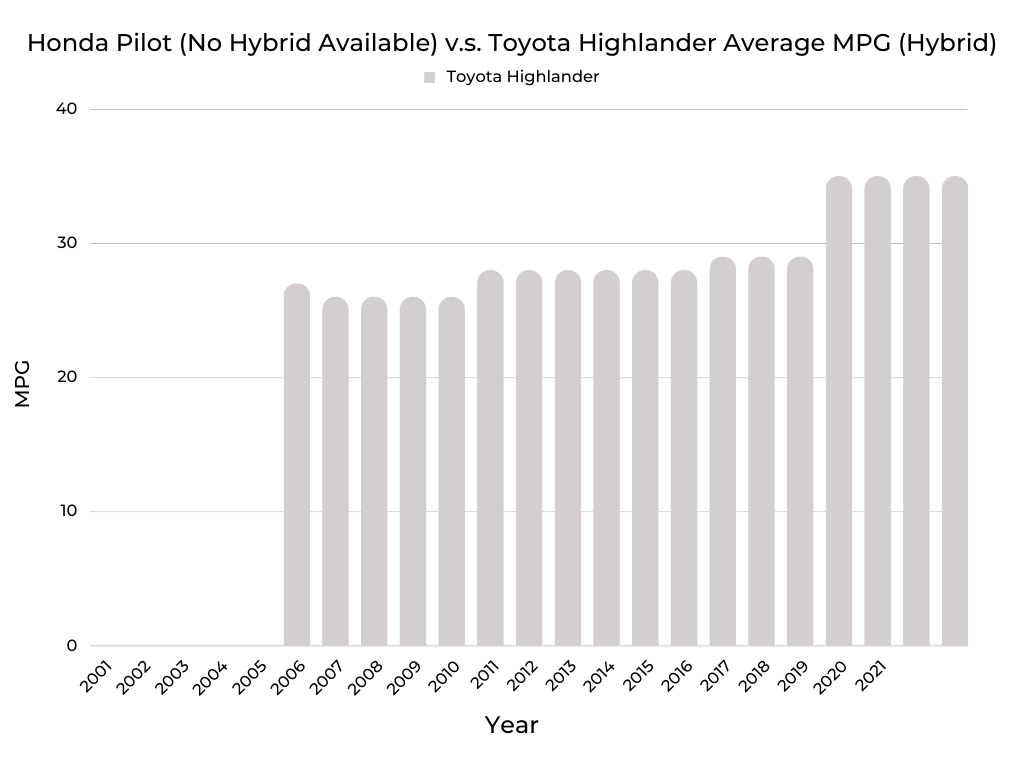Several great match-ups in the U.S. car market keep automakers and consumers on their toes. Vehicles like the Ford F-150 and Chevrolet Silverado have knocked heads for decades. We’ve seen similar contests with the Ford Mustang versus the Chevrolet Camaro. Even non-traditional pairings like the Honda Civic against the Toyota Camry are notable.
But in today’s SUV-obsessed environment, bread-and-butter vehicles like the Honda Pilot and Toyota Crossover also attract attention, especially among families. These three-row haulers can handle up to eight passengers, making them ideal for transporting a large clan.
Each vehicle has distinct advantages. The Pilot is larger and spacious, particularly in the third row. Meanwhile, the Highlander can claim better fuel economy, even more so when it comes in a hybrid version.
Let’s explore the competition between the Honda Pilot and Toyota Highlander. We’ll break down all the details for the 2023 model year and also highlight previous years as a guide for used car shoppers.
| Income Bracket | Monthly Financing Cost Range | Cash Purchase Price Range | Honda Pilot Years | Toyota Highlander Years | Best Model Year: | Why? |
| $5k – $10k | $83 – $125 | $3,000 – $4,500 | 2005 | 2002 | 2005 Pilot | Good engine reliability scores |
| $10k – $15k | $125 – $187 | $4,500 – $6,750 | 2009-2010 | 2007 | 2007 Highlander | Good engine reliability scores |
| $15k – $25k | $187 – $312 | $6,750 – $11,250 | 2011-2013 | 2009-2010 | 2013 Pilot | Excellent engine reliability scores |
| $25k – $35k | $312 – $437 | $11,250 – $15,750 | 2015-2016 | 2012, 2015 | 2016 Pilot | Excellent engine reliability scores and well priced |
| $35k – $50k | $437 – $625 | $15,750 – $22,500 | 2019 | 2017 | 2019 Pilot | Excellent engine reliability scores and well priced |
| $50k – $74k | $625 – $925 | $22,500 – $33,300 | 2021 | 2019 | Tie | Similar (excellent) engine reliability scores |
| $75k – $99k | $925 – $1,238 | $33,300 – $44,550 | n/a | 2021 | 2021 Highlander | Excellent engine reliability, no equivalent Pilot |
See the methodology for the table above.
Before you respond to the “For Sale” ad, check out this How to Buy a Used Car article for a step-by-step checklist.
Price History Comparison | Honda Pilot vs Toyota Highlander
Average Market Value – Based on Owners’ Self-Reported Mileages | Honda Pilot vs Toyota Highlander
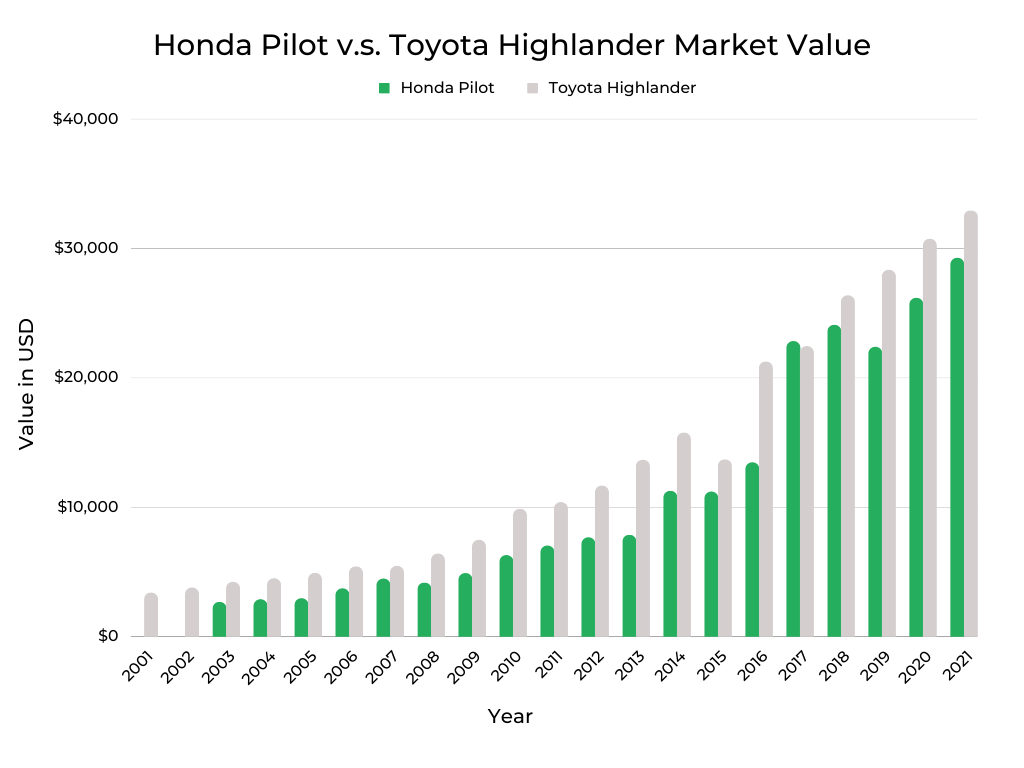
Pricing has a significant influence in used car purchases. This chart shows average private-party transactions for pre-owned Honda Pilots and Toyota Highlanders, according to Kelley Blue Book (KBB). Dealer prices are typically 10%–40% higher. So, you’ll want to adjust the budget upwards or look at older model years if you’re buying through a retailer.
Be aware that mileage directly impacts a vehicle’s value, which is also reflected in these two indexes. A vehicle with fewer miles is generally worth more than an identical car with greater use.
Charts like these should show a steady rise in market value with each more recent model year. And for the most part, this is what we see, especially with the Toyota Highlander (gray). 2015 is the only year that appears off. However, this is due to insufficient samples from owner surveys for this year.
Meanwhile, the Honda Pilot’s (green) data shows a rise in market value but with greater unevenness between the years. Some of these extremes are due to above- or below-average mileage among the surveyed vehicles. The Pilot didn’t debut until the 2003 model year. Hence, no data for 2001 and 2002.
Regardless, the most interesting insight from this chart is that the Highlander consistently has a stronger market value than the Pilot. This happens even though both vehicles have similar original selling prices (when new).
Be sure to read our Best and Worst Years series of articles that highlight the winners and losers of the Honda Pilot and Toyota Highlander.
Depreciation vs Maintenance Expenses
One of the downsides to buying a new car is the depreciation that kicks in the moment you leave the dealer. In normal times (when the car market isn’t so topsy-turvy), this can mean a drop in value of 40%–50% after the first five years. However, that’s been cut in half due to current inflationary conditions, according to the charts.
But even a depreciation rate of 20%–25% still results in new car buyers losing money. That’s why savvy shoppers turn to used cars. However, buying any second-hand Pilot or Highlander may not be the smartest approach.
Ideally, you want to find a “sweet spot” model year that has a history of reasonable repair and maintenance expenses. A look at the Honda Pilot chart shows that the 2003-2011 editions fall into this category. However, you’ll want to uncover more details by reviewing the best and worst Honda Pilot years.
For the Toyota Highlander, that means examining the 2002-2011 model years for examples that strike a balance between depreciation and maintenance. Explore the best and worst Toyota Highlander years before going any further.
Reliability Comparison | Honda Pilot vs Toyota Highlander
Two ratings are at the core of our look at the Honda Pilot and Toyota Highlander.
- The FIXD Reliability Score measures the number of check engine lights recorded for a particular model year by installed FIXD sensors. Think of it as an engine reliability score. While every check engine light doesn’t directly translate into reliability concerns (such as a dead battery or loose gas cap), these indicators still provide insight into a car’s dependability.
- The second rating is the Owner Reliability Score. This is a subjective ranking of how surveyed owners feel about their respective vehicle’s dependability. Each owner estimates how capable their car is for trips of different lengths. A vehicle that can handle a cross-country adventure receives the highest score, while a car only suitable for a quick point A to point B trip gets the lowest score.
Both rankings are based on 1 being the lowest, 10 being the highest, and 5 being the average score.
We’ll also point out that both scores seldom align. The FIXD Reliability Score is determined by a definitive number, the frequency of check engine lights. On the other hand, the Owner Reliability Score is opinion-based. And owners tend to have pride in their automobiles, with higher ratings as a result. At a minimum, those with older vehicles are more accepting of check engine lights. For many, it’s the price of owning an aging car.
The first chart compares the FIXD Reliability Scores of the Pilot and Highlander. And surprisingly, the Honda has fewer check engine lights than the Highlander for a majority of the comparison years (11 out of 19). No one would be blamed for believing these crossovers perform similarly, but the data shows otherwise. The Highlander topped the Pilot for engine reliability only for three years: 2006, 2007, and 2002. Five of the years are a tie.
The numbers take a different turn when looking at Owner Reliability Scores. In this case, the Highlander beats the Pilot, according to surveyed owners. The Highlander is ranked higher for seven years compared to five years for the Pilot. There’s a tie for seven years.
Review the Best and Worst Years articles on the Honda Pilot and Toyota Highlander to learn more about these vehicles’ FIXD Reliability and Owner Reliability Scores.
Longevity Comparison | Honda Pilot vs Toyota Highlander
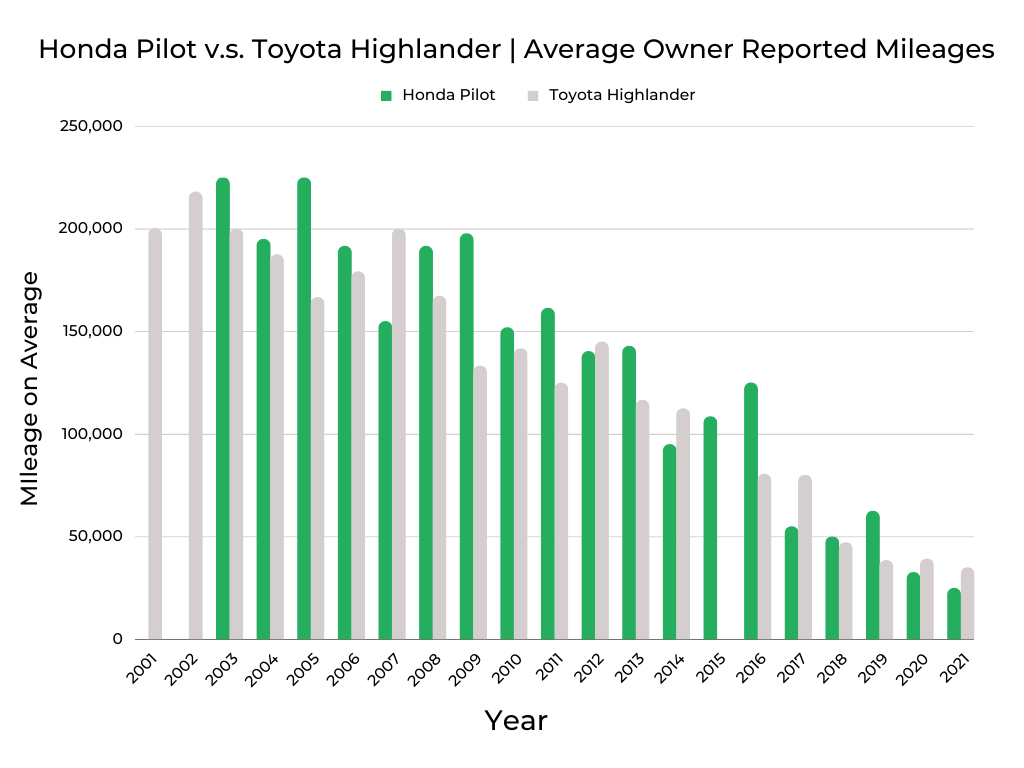
Based on the survey data highlighted in this chart, the Pilot and Highlander are evenly matched for longevity. Both vehicles are capable of reaching 150,000 miles if not 200,000 miles. Variations exist between the two brands and each model year, reflecting individual usage as reported in the FIXD surveys.
Reaching a high-mileage benchmark with a Pilot or Highlander has as much to do with upkeep and luck (avoiding accidents) as the quality of the car.
Review the individual articles on the best and worst years of the Honda Pilot and Toyota Highlander for a more thorough look at longevity.
2023 Honda Pilot vs Toyota Highlander | A Guide to Trim Levels & Optional Features
Trim Levels: Starting Prices
Seeing the similarity in pricing between the comparable trim levels is no surprise. If ever two vehicles were locked in heated competition for the same buyers, it’s the Honda Pilot and Toyota Highlander. For instance, only a $320 gap separates the base versions.
Move on to the mid-tier trims that have extra goodies (like a moonroof)—the Pilot EX-L ($42,300) and Highlander XLE ($42,020)—and there’s only $280 separating the two crossovers. However, don’t assume these vehicles fully align with the same features. The EX-L gets leather upholstery, while the XLE has SofTex (Toyota’s name for leatherette).
You’ll also see that the top-tier Pilot Elite ($52,380) and Highlander Platinum ($49,475) are separated by $2,905. This appears to make the Toyota a bargain, but it’s somewhat of an apples-to-oranges comparison because the Pilot Elite comes standard with all-wheel drive (AWD) while the Highlander Platinum is front-wheel drive (FWD). Adding AWD to the Toyota increases the price by $1,950, shrinking the void.
The only outlier is the Honda Pilot TrailSport, a relatively new addition to the lineup that features off-road capabilities. There is no Highlander equivalent (the XSE is an XLE with sportier looks). However, the smaller Toyota RAV4 has the TRD Off-Road trim. So, don’t be surprised if a Highlander TRD Pro surfaces in the future. These companies regularly play leapfrog against each other.
| 2023 Honda Pilot Model | Starting Price | 2023 Toyota Highlander Model | Starting Price | |
| LX | $36,300 | L | $36,620 | |
| Sport | $39,500 | LE | $39,020 | |
| EX-L | $42,300 | XLE | $42,020 | |
| TrailSport | $48,700 | XSE | $43,615 | |
| Touring | $46,800 | Limited | $46,275 | |
| Elite | $52,380 | Platinum | $49,475 |
We’ve separated the pricing for the Highlander Hybrid because the Pilot doesn’t come in a hybrid. What’s particularly interesting is that Toyota only charges a $1,600 premium for the Hybrid. This is cheap as the company usually tacks on another $3,000 or so for the same upgrade in other models. This strategy likely helps improve the overall fuel economy average for the Highlander. The federal government penalizes automakers if their vehicles don’t meet specific mileage standards.
We’ll close this part of the conversation by mentioning that there’s no conventional gas-powered Highlander equivalent to the Highlander Hybrid Bronze Edition. Think of it as an XLE with technology upgrades and unique exterior treatments.
| 2023 Toyota Highlander Model | Starting Price |
| Hybrid LE | $40,620 |
| Hybrid XLE | $43,620 |
| Hybrid Bronze Edition | $46,380 |
| Hybrid Limited | $47,875 |
2023 | Honda Pilot vs Toyota Highlander | Specifications | Safety, Interior and Exterior Features
There’s more to comparing the Honda Pilot and Toyota Highlander than prices. Let’s review the various specifications for these two vehicles and see how things stack up.
Vehicle Class & Body Style:
Both the Pilot and Highlander are categorized as standard/mid-size SUVs by the EPA (the U.S. Environmental Protection Agency). This classification is based on interior passenger volume. But even though these crossovers are grouped together, there’s a noticeable difference in interior space. The Pilot has up to 158.4 cubic feet of passenger volume against as much as 142 cubic feet for the Highlander. Do the math, and you’ll find that the Pilot is about 12% larger inside than the Highlander.
To put these measurements in perspective, the current Honda Odyssey minivan has 172.6 cubic feet of interior space.
| 2023 Honda Pilot | 2023 Toyota Highlander | |
| Class | Mid-Size SUV | Mid Size SUV |
| 4-Door SUV | LX, Sport, EX-L, TrailSport, Touring, Elite | L, LE, XLE, XSE, Limited, Platinum, Hybrid LE, Hybrid XLE, Hybrid Bronze Edition, Hybrid Limited, Hybrid Platinum |
Powertrain:
Engine Options & Specifications:
Perhaps the greatest difference between the 2023 editions of the Honda Pilot and Toyota Highlander lies under their respective hoods. The Pilot relies on a non-turbo 285-horsepower 3.5-liter V6. It’s the same basic engine that’s been in this SUV since the beginning of the model. Honda also uses variations of this J-series V6 in the Odyssey minivan, Ridgeline pickup, and Acura MDX crossover. These engines won’t outrace a sports car, but they offer a nice balance of performance and economy.
V6s used to occupy the engine bays of many Highlanders, but Toyota axed this approach for the 2023 model year. Now, non-hybrid Highlanders only come with a turbocharged 2.4-liter four-cylinder engine. The new engine makes 265 horsepower, a 30-horsepower drop from the V6 from the previous year.
Why did Toyota make the change? Two reasons. Better fuel economy and a four-cylinder engine is cheaper to manufacture. It’s safe to say that shoppers of three-row crossovers are more concerned with saving money than 0-60 MPH times. However, if performance is clearly a factor, buyers may lean towards the Pilot; it’s slightly quicker than the Highlander (6.7-6.9 seconds versus 7.5 seconds).
To Toyota’s credit, the Highlander’s new engine offers standard-for-its-class towing capacity. A 5,000-pound hauling limit means bringing along a pop-up camper or fishing boat and trailer combo is realistic. The Highlander Hybrid is rated for a 3,500-pound tow limit. With front-wheel drive, the Pilot can handle 3,500 pounds, but its towing limit increases to 5,000 pounds with the addition of all-wheel drive. Most vehicles in this class—such as the Chevrolet Traverse and Ford Explorer—also have similar towing capabilities.

We’ll get into a broader conversation about fuel economy below, but highlighting the Highlander Hybrid’s fuel economy is worthwhile. Impressively, this is a third-row vehicle that delivers 35 MPG. But, arguably, this is the only advantage of the Highlander Hybrid. It costs more, tows less, and is slower than the standard Highlander.

Transmission Options & Specifications:
Transmissions and crossovers aren’t likely to stir up a lively dialogue. Yet, knowing what manages the drivetrains in the Pilot and Highlander is still helpful.
The Pilot comes with a ten-speed automatic transmission regardless of the configuration (FWD or AWD). It’s a state-of-the-art gearbox that Honda has engineered to deliver a balance between acceleration and fuel economy.
Meanwhile, the non-hybrid Highlander also gets an automatic transmission, but with eight speeds. In truth, the average consumer cannot tell the difference between ten-speed and eight-speed automatic transmissions. So, making a buying decision on this one feature will be a wasted effort.
The Highlander Hybrid, however, uses a self-shifting continuously variable transmission (CVT). These units are oriented more toward fuel economy, which makes sense given the Highlander Hybrid is focused on gas-sipping.
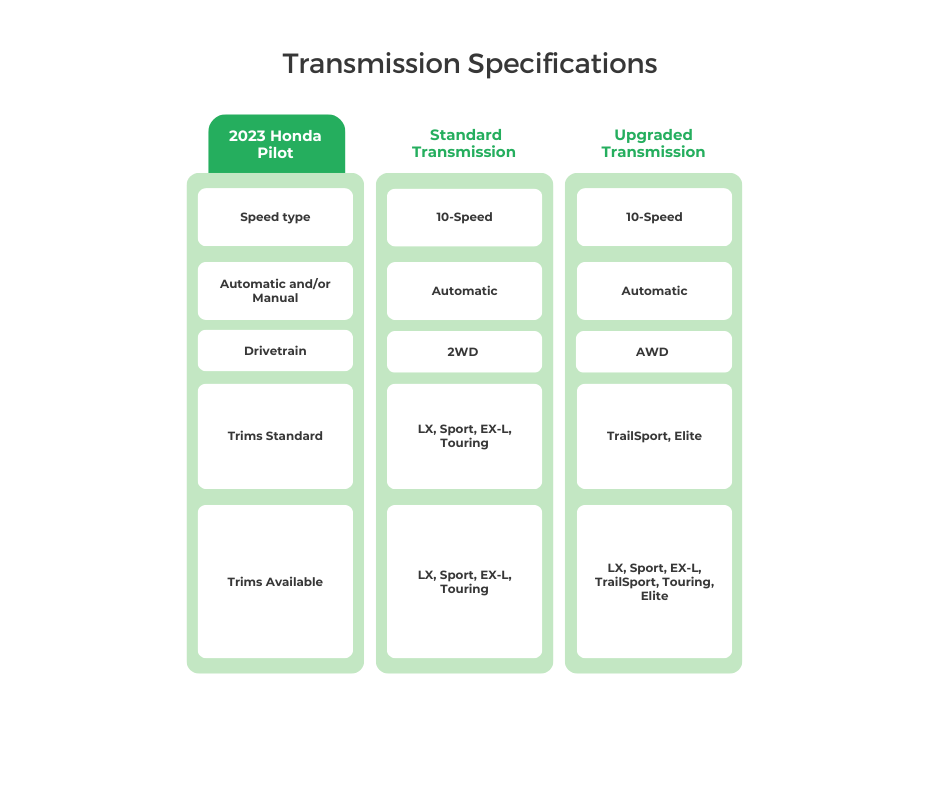
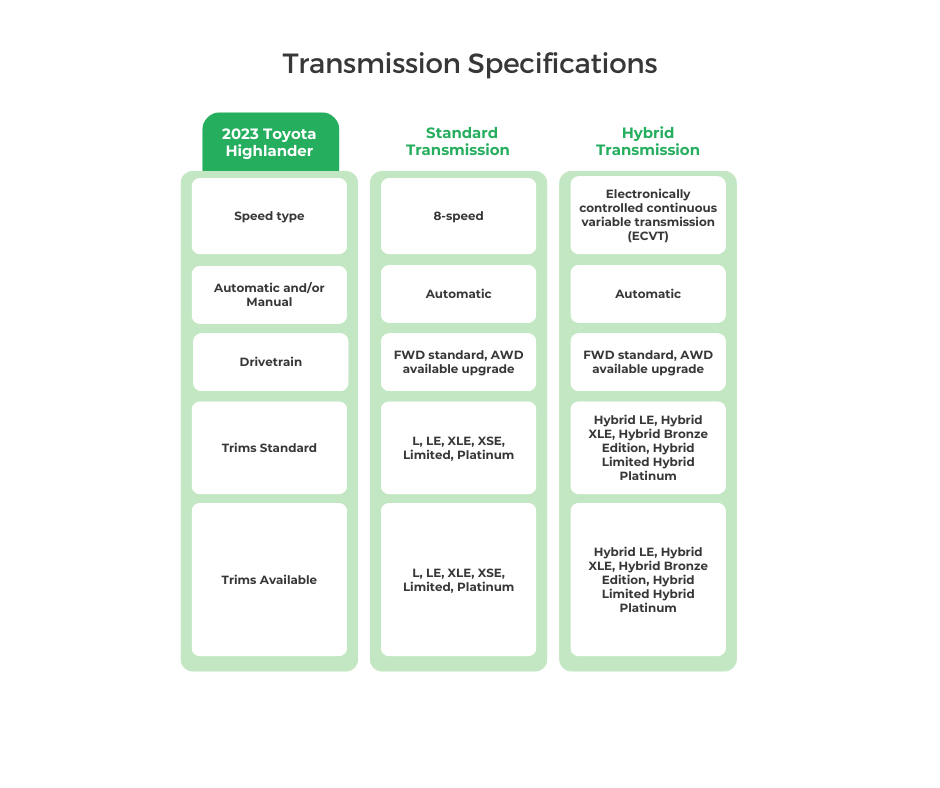
Drivetrain:
Early on, automakers realized that not all SUV buyers wanted or needed all-wheel drive. Add in that most crossover platforms have passenger car roots (the Highlander has Camry DNA), and the idea of offering front-wheel drive makes sense. FWD is less expensive, gets better fuel economy, and is simpler to repair. Plus, FWD offers decent traction, especially in locales that just get minor snowfalls.
Wisely, Honda and Toyota offer a drivetrain choice for most Pilot and Highlander buyers. The only exception is that AWD is standard with the Pilot TrailSport and Elite. Those wanting a high-end family crossover without AWD will need to steer toward the Highlander Platinum.
| 2023 Honda Pilot Wheel Drive | FWD | AWD | RWD |
| LX | S | U | |
| Sport | S | U | |
| EX-L | S | U | |
| TrailSport | S | ||
| Touring | S | U | |
| Elite | S |
Key: S = Standard, U = Upgrade
| 2023 Toyota Highlander Wheel Drive | FWD | AWD | RWD |
| L | S | U | |
| LE | S | U | |
| XLE | S | U | |
| XSE | S | U | |
| Limited | S | U | |
| Platinum | S | U | |
| Hybrid LE | S | U | |
| Hybrid XLE | S | U | |
| Hybrid Bronze Edition | S | U | |
| Hybrid Limited | S | U | |
| Hybrid Platinum | S | U |
Safety:
NHTSA Safety Ratings
According to FIXD survey data, about half of those with a Honda Pilot (50%) or Toyota Highlander (47%) rely on their cars for family hauling duties. Meanwhile, another 29% of Pilot owners spend significant time traveling and commuting. Likewise, 27% of Highlander owners perform similar tasks.
All this use points to the importance of driving a safe car. Let’s examine the crash test overviews from the National Highway Traffic Safety Administration (NHTSA) for these vehicles. Unfortunately, there are no results for the 2023 Pilot because it’s the first year of the fourth generation; this isn’t unusual. Because the new Pilot is an all-new design, looking at earlier years isn’t helpful. However, it’s a safe bet that Honda engineers created the 2023 Pilot with solid crash test performance in mind. So, expect the newest Pilot to perform similarly to previous generations and the Highlander.
And speaking of the Highlander, this Toyota does well in NHTSA testing, receiving an overall 5 out of 5. Yet, the Highlander dropped to a 4 (out of 5) in the frontal crash test, which is still respectable. A rollover rating of 4 is very typical of crossovers as they have a higher center of gravity than traditional passenger cars.
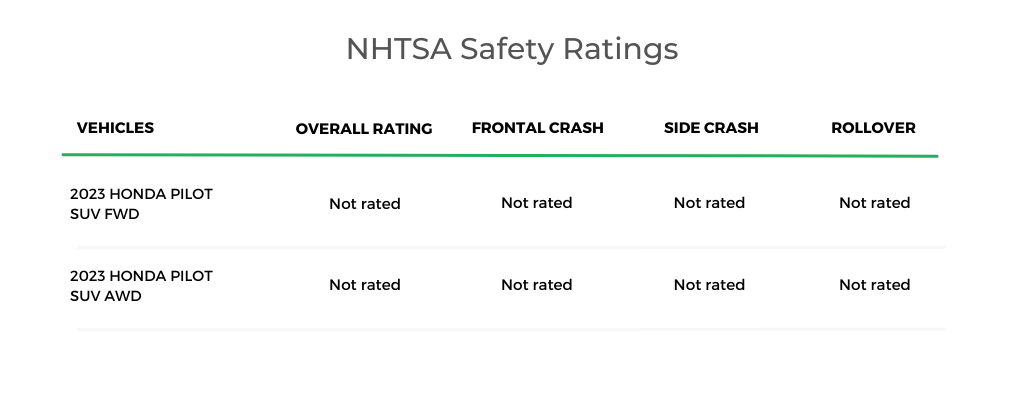

IIHS Awards:
The Insurance Institute for Highway Safety (IIHS) takes a somewhat different approach to safety testing. In particular, it focuses on its small frontal overlap crash test, which the organization feels represents a more real-world scenario (a single car running into a fixed object). IIHS also looks at side impact crashes, roof strength, headlight effectiveness, and advanced driver safety technologies (like automatic emergency braking).
While tested vehicles receive a Good, Acceptable, Marginal, or Poor grade, the true measure comes if a car gets a Top Safety Pick or Top Safety Pick+ designation. If “Good” is a “B” grade, Top Safety Pick notches things up to an “A-,” and the Top Safety Pick+ signifies an “A+”
Both the 2023 Honda Pilot and 2023 Toyota Highlander scored Top Safety Pick+ wins from IIHS.
| IIHS Award | Tested Vehicle | ||
| 2023 Honda Pilot | Midsize SUV/4-Door SUV | 2023 TOP SAFETY PICK + | 2023 Honda Pilot Elite 4-door 4WD |
| 2023 Toyota Highlander | Midsize SUV/4-Door SUV | 2023 TOP SAFETY PICK + | 2020 Toyota Highlander LE 4-door AWD |
Airbags & Head Restraints:
One of the key safety systems in today’s vehicles is airbags. Naturally, they are abundant in the Pilot and Highlander. Both cars have front and side impact units. However, the Pilot has knee airbags for both front seat occupants, while the Highlander offers this only for the driver. A knee airbag helps properly position the protected passenger during a collision.
While these vehicles don’t have overhead airbags, the Pilot and Highlander have three-row side curtain airbags that protect occupants during a rollover or side-impact collision. To clarify, overhead airbags are newer front seat systems that substitute dash-mounted systems for overhead devices.
It’s not unusual to find active head restraints absent from mainstream vehicles like the Pilot and Highlander. These units, designed to reduce whiplash injuries, are more common in higher-end cars.
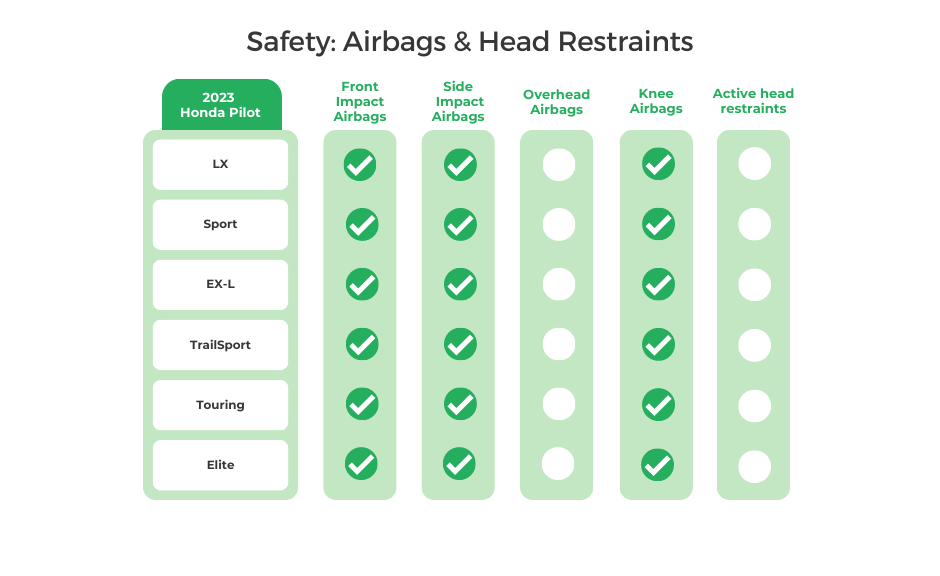
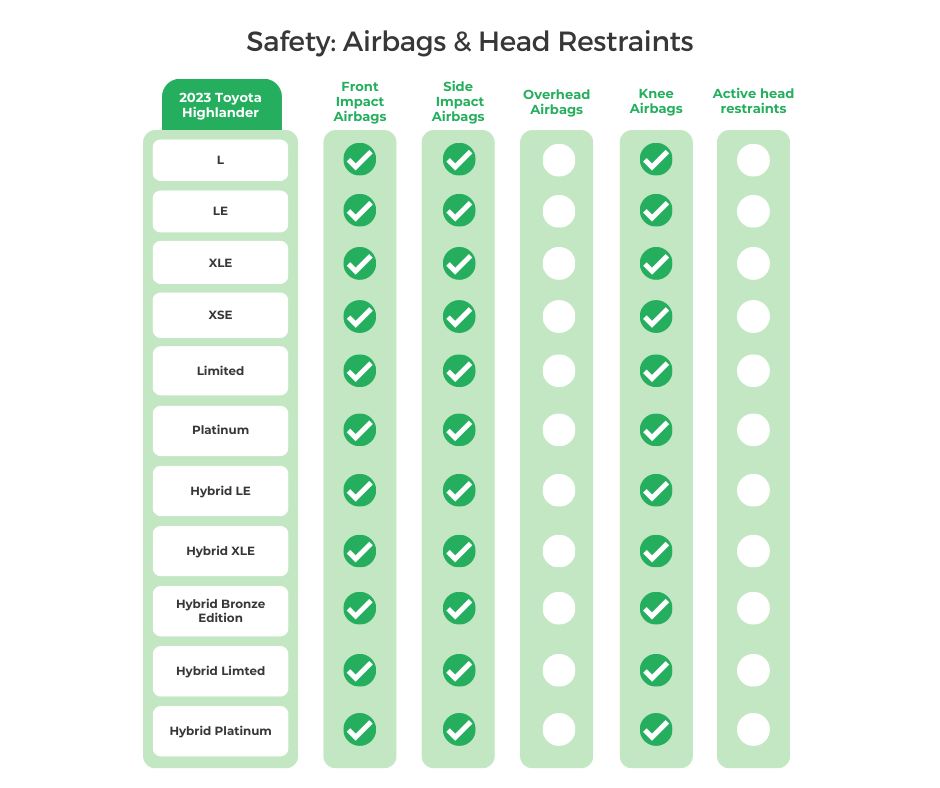
Semi-Autonomous Driving:
Although the Pilot and Highlander are rolling technological wonders, neither car offers a hands-free driving system like in a Tesla or some vehicles from Mercedes-Benz or Ford (and some other brands).
Instead, these crossovers are equipped with an array of supportive technology designed to keep drivers and their passengers safer. Some of these systems are semi-autonomous. For instance, adaptive cruise control (ACC) offers great convenience with stop-and-go traffic during highway travel. When in use, ACC will automatically stop a vehicle (or reduce speed) when it senses slower or stand-still traffic ahead. The system will return the car to cruising speed when proper conditions are detected. However, the driver must still hold the wheel at all times.
Both cars come with corrective steering support during normal driving. Honda calls it Road Departure Mitigation, while Toyota uses the term Lane Departure Alert with Steering Assist. The systems work the same way by alerting the driver if the car is not correctly positioned in the lane and may offer subtle steering guidance to return the vehicle to the correct lane placement. All of this depends on these systems having properly functioning sensors that can read road markings.
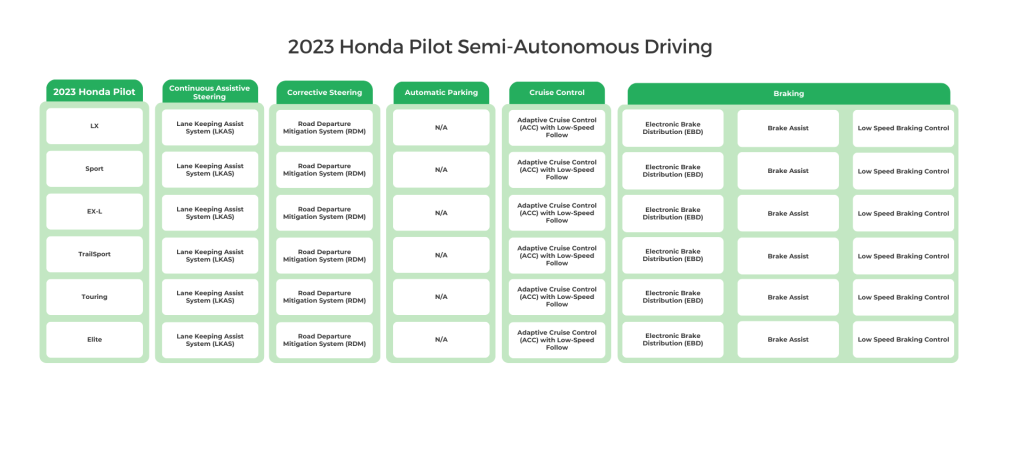
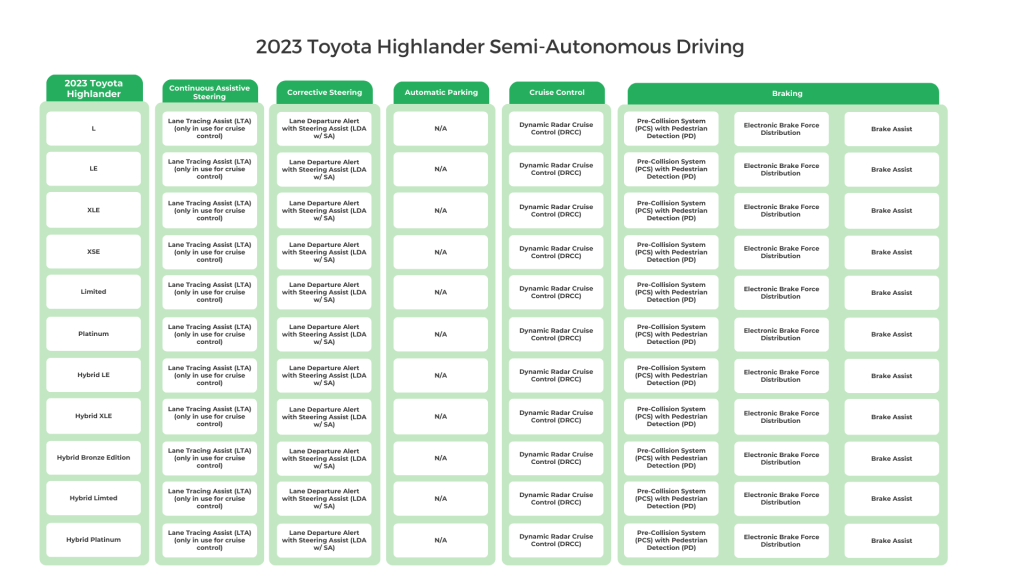
Driver Warning Systems & Telematics:
Given the family-first mission of the Honda Pilot and Toyota Highlander, it’s expected for these crossovers to be equipped with advanced driver assistance systems (ADAS).
Features like forward collision warning (FCW) and lane departure warning (LDW) alert the driver if the vehicle is operated unsafely. Forward collision warning (FCW) signals if there’s a potential collision ahead, while automatic emergency braking (AEB) stops the car to prevent or minimize the crash. While not defined in the charts below, AEB is a standard feature in most new vehicles sold today, including the Pilot and Highlander.
Blind-spot monitoring (BSM) and rear cross-traffic alert (RCTA) are other useful driver aids, but they’re not available on the base trims of the Pilot and Highlander. The value of these technologies is immeasurable, making a move up to a next-level trim worthwhile.
There are convenient reminders to be aware of. Rear occupant alert warns if a back-seat passenger is present (preventing a child from being locked in the car). Exclusive to the 2023 Pilot is a driver attention monitor, which advises drivers if their focus shifts from the road ahead. Traffic Sign Recognition (TSR) is another helpful tool that reinforces the posted speed limit and command signs (like stop or do not enter). TSR is standard across the Pilot range but comes only on the top-tier Highlander.
If ADAS technology appears like alphabet soup, check out an effort from AAA, Consumer Reports, J.D. Power, and other groups working to standardize the terminology for these systems.
| 2023 Honda Pilot | Driver Warning Systems | Telematics | |||||||||
| Intersection Turn Assistance (ITA) | Lane Departure Warning (LDW) | Traffic Sign Recognition(TSR) | Forward Collision Warning (FCW) | Pedestrian Detection | Rear Cross-Traffic Alert (RCTA) | Blind-Spot Monitoring (BSM) | Driver Attention Monitor | Safe Exit | Rear Occupant Alert | ||
| LX | N/A | Lane Departure Warning | Traffic Sign Recognition | Forward Collision Warning | Collision Mitigation Braking System (CMBS) | N/A | N/A | Driver Attention Monitor | N/A | Rear Seat Reminder (RSR) | HondaLink |
| Sport | N/A | Lane Departure Warning | Traffic Sign Recognition | Forward Collision Warning | Collision Mitigation Braking System (CMBS) | Cross Traffic Monitor | Blind Spot Information System (BSI) | Driver Attention Monitor | N/A | Rear Seat Reminder (RSR) | HondaLink |
| EX-L | N/A | Lane Departure Warning | Traffic Sign Recognition | Forward Collision Warning | Collision Mitigation Braking System (CMBS) | Cross Traffic Monitor | Blind Spot Information System (BSI) | Driver Attention Monitor | N/A | Rear Seat Reminder (RSR) | HondaLink |
| TrailSport | N/A | Lane Departure Warning | Traffic Sign Recognition | Forward Collision Warning | Collision Mitigation Braking System (CMBS) | Cross Traffic Monitor | Blind Spot Information System (BSI) | Driver Attention Monitor | N/A | Rear Seat Reminder (RSR) | HondaLink |
| Touring | N/A | Lane Departure Warning | Traffic Sign Recognition | Forward Collision Warning | Collision Mitigation Braking System (CMBS) | Cross Traffic Monitor | Blind Spot Information System (BSI) | Driver Attention Monitor | N/A | Rear Seat Reminder (RSR) | HondaLink |
| Elite | N/A | Lane Departure Warning | Traffic Sign Recognition | Forward Collision Warning | Collision Mitigation Braking System (CMBS) | Cross Traffic Monitor | Blind Spot Information System (BSI) | Driver Attention Monitor | N/A | Rear Seat Reminder (RSR) | HondaLink |
| 2023 Toyota Highlander | Driver Warning Systems | Telematics | |||||||||
| Intersection Turn Assistance (ITA) | Lane Departure Warning (LDW) | Traffic Sign Recognition (TSR) | Forward Collision Warning (FCW) | Pedestrian Detection | Rear Cross-Traffic Alert (RCTA) | Blind-Spot Monitoring (BSM) | Driver Attention Monitor | Safe Exit | Rear Occupant Alert | ||
| L | N/A | Lane Departure Alert (LDA) | N/A | Pre-Collision System (PCS) | Pedestrian Detection (PD) | N/A | N/A | N/A | N/A | Rear Seat Reminder | N/A |
| LE | N/A | Lane Departure Alert (LDA) | N/A | Pre-Collision System (PCS) | Pedestrian Detection (PD) | Rear Cross-Traffic Alert (RCTA) | Blind Spot Warning Indicator | N/A | N/A | Rear Seat Reminder | N/A |
| XLE | N/A | Lane Departure Alert (LDA) | N/A | Pre-Collision System (PCS) | Pedestrian Detection (PD) | N/A | Blind Spot Warning Indicator | N/A | N/A | Rear Seat Reminder | N/A |
| XSE | N/A | Lane Departure Alert (LDA) | N/A | Pre-Collision System (PCS) | Pedestrian Detection (PD) | N/A | Blind Spot Warning Indicator | N/A | N/A | Rear Seat Reminder | N/A |
| Limited | N/A | Lane Departure Alert (LDA) | N/A | Pre-Collision System (PCS) | Pedestrian Detection (PD) | N/A | Blind Spot Warning Indicator | N/A | N/A | Rear Seat Reminder | N/A |
| Platinum | N/A | Lane Departure Alert (LDA) | Road Sign Assist (RSA) | Pre-Collision System (PCS) | Pedestrian Detection (PD) | N/A | Blind Spot Warning Indicator | N/A | N/A | Rear Seat Reminder | N/A |
| Hybrid LE | N/A | Lane Departure Alert (LDA) | N/A | Pre-Collision System (PCS) | Pedestrian Detection (PD) | Rear Cross-Traffic Alert (RCTA) | Blind Spot Warning Indicator | N/A | N/A | Rear Seat Reminder | N/A |
| Hybrid XLE | N/A | Lane Departure Alert (LDA) | N/A | Pre-Collision System (PCS) | Pedestrian Detection (PD) | N/A | Blind Spot Warning Indicator | N/A | N/A | Rear Seat Reminder | N/A |
| Hybrid Bronze Edition | N/A | Lane Departure Alert (LDA) | N/A | Pre-Collision System (PCS) | Pedestrian Detection (PD) | N/A | Blind Spot Warning Indicator | N/A | N/A | Rear Seat Reminder | N/A |
| Hybrid Limited | N/A | Lane Departure Alert (LDA) | N/A | Pre-Collision System (PCS) | Pedestrian Detection (PD) | N/A | Blind Spot Warning Indicator | N/A | N/A | Rear Seat Reminder | N/A |
| Hybrid Platinum | N/A | Lane Departure Alert (LDA) | Road Sign Assist (RSA) | Pre-Collision System (PCS) | Pedestrian Detection (PD) | N/A | Blind Spot Warning Indicator | N/A | N/A | Rear Seat Reminder | N/A |
Road Visibility Features:
The 2023 Honda Pilot and 2023 Toyota Highlander are fairly evenly matched when it comes to visibility features like LED headlights and automatic high beams. And advanced equipment, such as a head-up display (which presents speed and other vital information on the windshield) and rain-sensing windshield wipers, are reserved exclusively for the top trims. But, the Highlander gains a slight edge by offering adaptive headlights (which adjust in sync with the steering wheel for better illumination). This upgrade only comes with the Platinum versions of the Highlander and Highlander Hybrid, it’s unavailable at any price on the Pilot.
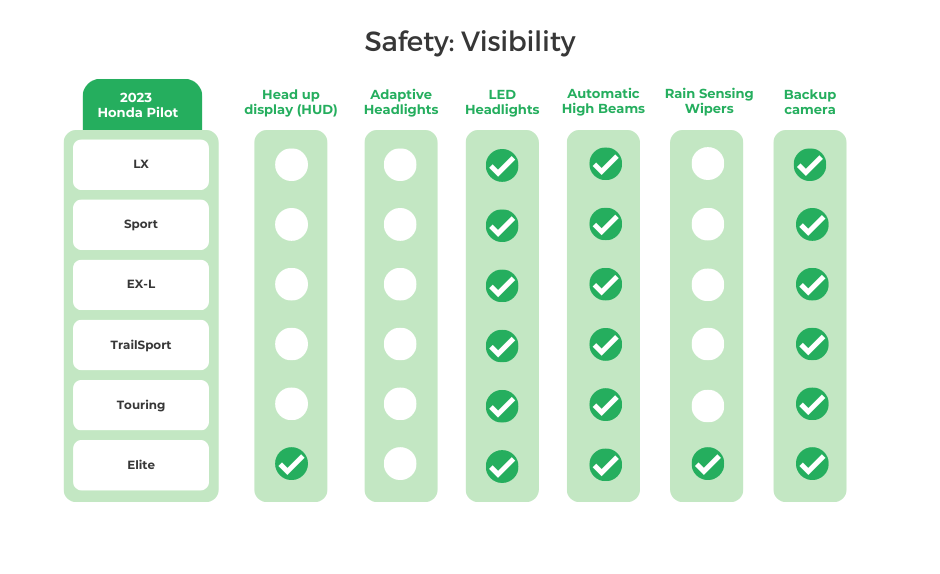
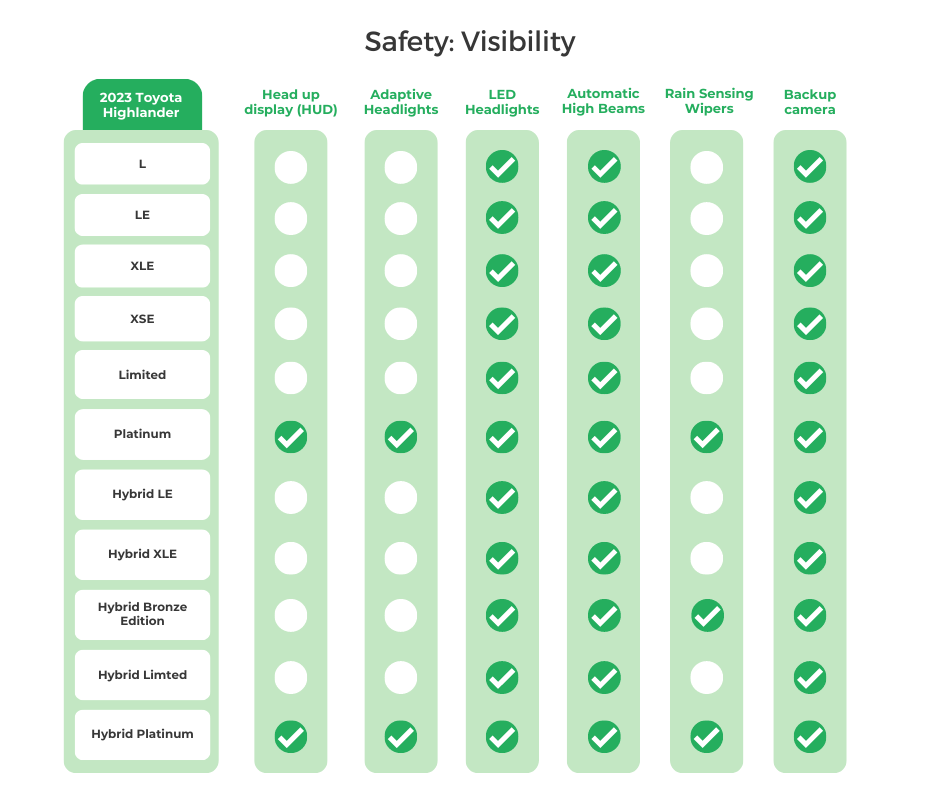
Interior:
Interior Features:
Certain must-have features can make a difference for some car buyers. Smartphone-dependant drivers will appreciate that Apple CarPlay and Android Auto are standard with every 2023 Pilot and 2023 Highlander.
However, you’ll need to be more choosy if heated front seats are a must-have. This feature is standard on all Pilot trims except the base LX. Similarly, heated seats don’t come with the Highlander L or LE or the Highlander Hybrid LE. Nor does Toyota make these an option.
And speaking of heated seats, some automakers offer this feature through a subscription service. This hasn’t yet happened in the U.S., but in certain countries, BMW is offering heated seats for a monthly fee. The advantage is you can shut off the service during warm months, but you’ll need to keep paying (or pay a one-time upfront fee) to activate the heated seats.
One industry study shows mixed results for consumer acceptance of features on demand (FoD), with about one-fifth not even being aware of the concept.

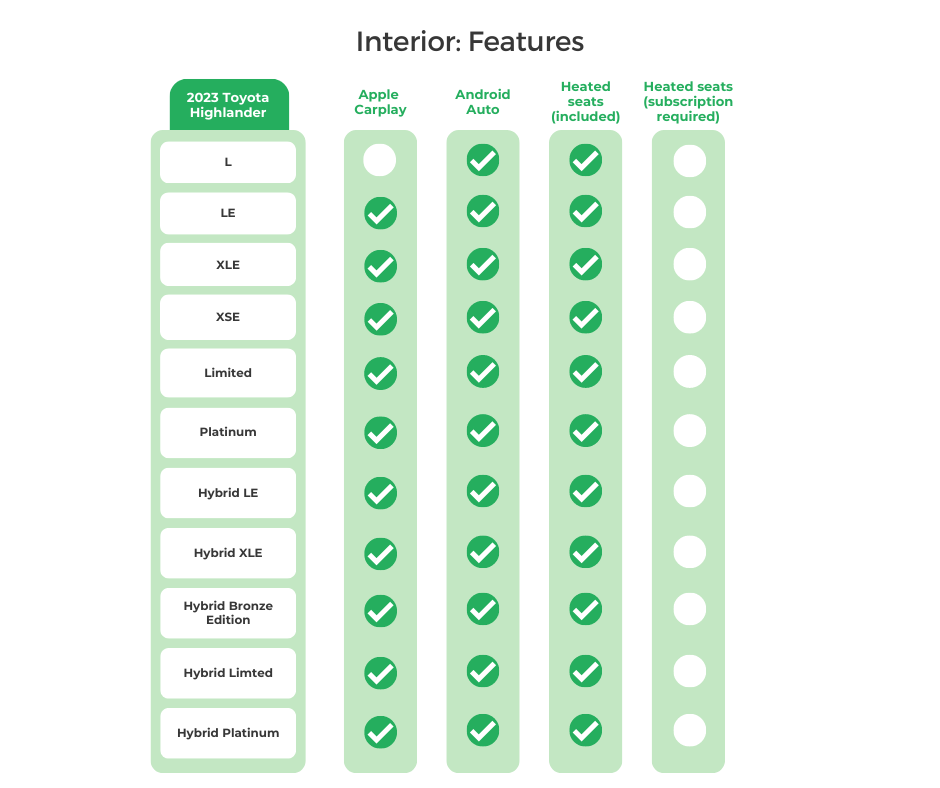
Interior Dimensions:
As mentioned, the Pilot is about 12% larger inside than the Highlander. There are some dimensional differences among the Highlander trims because Hybrid batteries and other equipment can take up extra space. This contrast between the Pilot and Highlander translates into noticeable differences in key measurements.
In particular, the Pilot has 32.5 inches of reasonable third-row legroom. You might not want to sit in the back of this bus for a cross-country trip, but a local or regional trip won’t be too bad for all but the tallest individuals. The same can’t be said for the Highlander. Its third row has 28.5 inches, which is about the same space as what’s available in the cheap seats of a low-budget airline.
The Pilot also excels in shoulder room (in all three rows) and maximum cargo space. But don’t sell the Highlander short. There are some interior dimensions where it beats the Pilot. Chiefly, we’re talking about better front legroom (42 inches vs. 41 inches) and front headroom (41 inches vs 39.5 inches in the base trims).
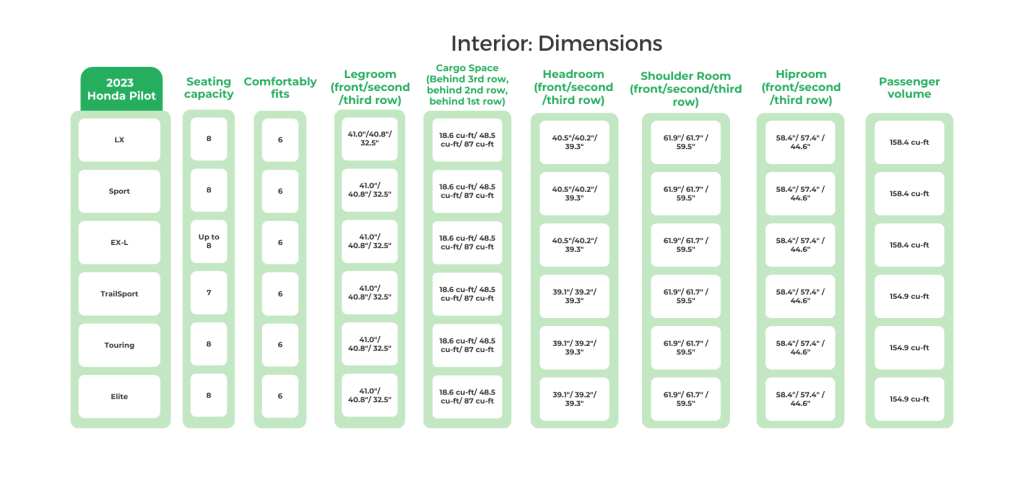
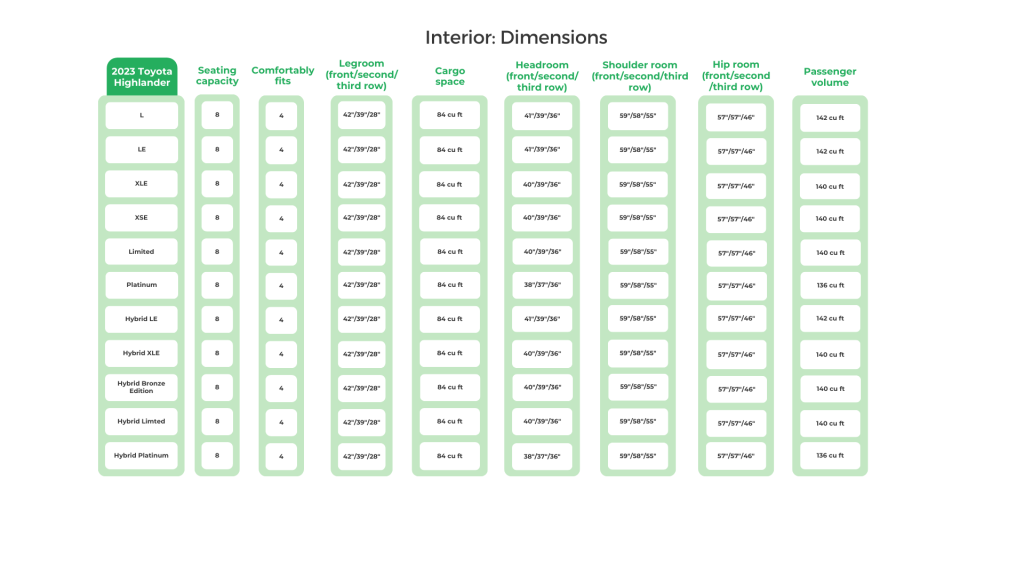
Exterior:
Exterior Features:
Wheels may also be an afterthought for many car buyers. But wheel size can impact ride quality. Larger rims can translate into better traction and cornering but may result in a bumpier ride. Bigger wheels also offer better aesthetics by filling out the wheel wells more completely. This is why the higher the trim, the larger the wheel. Different materials (steel or alloy) and finishes also help separate the wheels among the various trim levels.
If vibrant colors are your thing, you’ll be left disappointed by the white, gray, silver, and black shades that make up most of the exterior tones for the Pilot and Highlander. To stand out in the crowd, you may want to choose a red or blue that both manufacturers offer.
The one exception to this sea of sameness is that the Pilot TrailSport is available in Diffused Sky Blue Pearl, a bright blue making the rounds among other automakers (but not Toyota).
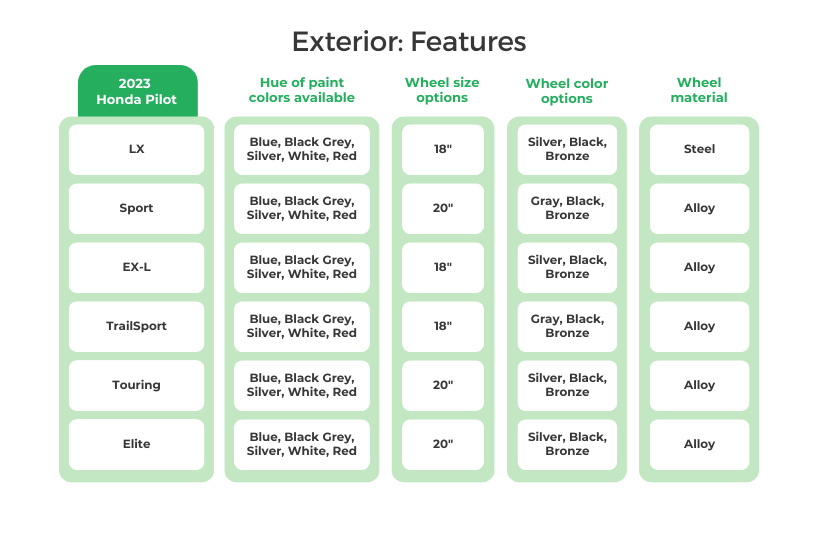

Exterior Dimensions:
The Honda Pilot is larger on the inside than the Toyota Highlander. So, it goes without saying that the Pilot is also bigger on the outside. It’s an essential consideration if you’ve got a tight garage space to fit in or if the idea of driving a more significant crossover is unsettling.
Given we’re talking about crossovers, a mention of ground clearance is necessary. Tall ground clearance is better for traveling across unpaved roads but can make vehicle entry and exit more challenging. Ground clearance measures 7.3 inches for the Pilot and 8.0 inches for the Highlander. However, the off-road-oriented Pilot TrailPost has 8.3 inches of ground clearance. In comparison, most versions of the 2023 Jeep Wrangler have 9.7 inches of ground clearance.


Warranty:
For the most part, Pilot and Highlander warranty coverage is similar. Both vehicles have bumper-to-bumper protection for 36 months or 36,000 miles. The respective manufacturers also cover the powertrain (engine, transmission, and drive axles) for 60 months or 60,000 miles.
However, the Pilot gets an additional year of roadside assistance and air conditioning protection (for recharging the system, which is unusual in a newer car).
| 2023 Honda Pilot Factory Warranty Coverage: | 2023 Toyota Highlander Factory Warranty Coverage: | |
| Basic warranty: | 36 Months/36,000 miles | 36 Months/36,000 Miles |
| Powertrain warranty: | 60 months/60,000 miles | 60 Months/60,000 Miles |
| Corrosion perforation warranty: | 60 months/Unlimited miles | 60 Months |
| Air conditioning warranty: | 24 Months/24,000 miles | 12 Months/12,000 Miles |
| Battery warranty: | 36 Months/36,000 miles | 120 months/150,000 miles (Hybrid Battery) |
| Emissions warranty: | Federal: 36 Months/36,000 miles California: 36 Months/50,000 miles | Federal: 36 month/36,000 miles (defect), 24 months/24,000 miles (performance)California: 36 months/50,000 miles (performance) |
| Roadside assistance coverage: | 36 months/36,000 miles | 24 months/25,000 miles |
| Total unique recalls: | none | 1 (recall no. 23V480000) |
Driver Experience | A Summary of The Top 10 Honda Pilot vs Toyota Highlander Reddit Posts:
Let’s explore some recent Reddit comments (Reddit: r/whatcarshouldIbuy) comparing the Pilot and Highlander.
An unscientific look at this feedback reveals that the Pilot has a slight edge in favorability over the Highlander. For example, one Redditor remarked, “I prefer the Honda Pilot because of its better safety features and reliability. The Toyota Highlander is good too, but the Pilot edges it out in these aspects.”
Yet, subjectivity can swing in the Highlander’s favor, with one commenter mentioning, “I prefer the Toyota Highlander because of its sleek design and better resale value. The Honda Pilot looks a bit boxy in comparison.”
Regardless of things leaning toward the Pilot’s side, there were no recent bad words about the Highlander. Overall, this input was more about expressing preferences rather than disparagement.
Here are some other highlights.
Usability
Some Redditors pointed out that the Pilot’s more powerful engine made for a better towing vehicle, even though the two cars are roughly similar in this capability (and FWD Pilots have less towing ability than the standard Highlander).
A comparison between these cars’ infotainment systems gives praise to the Pilot’s user-friendly equipment versus the Highlander’s setup, that’s “a bit confusing to navigate.”
Fuel Economy
The Pilot’s larger engine has one drawback, more trips to the gas station. Multiple comments cited the Highlander’s better fuel economy as a real positive to ownership compared to the Honda.
Space
The back-and-forth tennis match continues as several Redditors called out the Pilot for its larger cabin. “Spacious and comfortable” third-row seating is one of the Pilot’s strong points, as is ample cargo space. Perhaps, the most negative comment about the Highlander is that it “felt cramped in comparison.”
Comfort
There were definitive opinions about ride comfort. One Redditor stated, “Both the Honda Pilot and Toyota Highlander are great options, but I found the Highlander to have a smoother and quieter ride overall.” Another post seconded this: “I test drove both, and the Toyota Highlander had a smoother ride and better handling. The Honda Pilot felt a bit bulkier on the road.”
Who Should Buy These Cars: The Legacy of The Honda Pilot and Toyota Highlander
The tit-for-tat comparisons between the Honda Pilot and Toyota Highlander continue with how owners use these crossovers. First and foremost, these vehicles are family cars. That’s the primary purpose of three rows, even if the furthest back seats only get used occasionally.
The Pilot and Highlander are equally tasked with “Lots of Driving.” So whether this involves commuting or long-distance travel, these owners rack up more highway miles. This type of driving is less demanding on a car than the rigors of stop-and-go city use.
And FIXD survey data shows these crossovers can easily reach the 150,000-mile mark if not the 200,000-mile threshold. Highway driving helps high mileage become an expectation with the Pilot and Highlander, not an exception.
| Frequent Use Categories: | Honda Pilot | How Useful? (Out of 5 Stars) | Toyota Highlander | How Useful? (Out of 5 Stars) |
| Family Vehicle | * * * * * | * * * * * |
| Lots of Driving (travel/long commute) | * * * | * * * |
| Hauling/Towing | * | * * |
| Office on Wheels | * | * |
| Sport/Fast Driving | * | * |
| Luxurious Driving | * | * |
| Outdoor/Off-Road | * | * |
Best & Worst Years | Honda Pilot vs Toyota Highlander | 2001-2024

Unsurprisingly, the bulk of the worst years of the Pilot and Highlander are among the earliest years of these models. Regardless of Honda’s and Toyota’s reputations for reliability, 20-year-old cars just don’t hold up as well as more recent examples.
Unless you’re dealing with a very tight budget, you’ll want to start searching for a 2009 or newer Pilot or Highlander (of course, skipping the years marked in red). The undecided years are too recent to assess thoroughly, so be extra cautious if you’re considering a used example from 2022-2024.
If cheap transportation is the order of the day, concentrate your efforts on a 2005 Pilot or 2007 Highlander. Consider the 2002 Highlander the least-best example to spend your money on.
Important Features Timeline | Honda Pilot vs Toyota Highlander
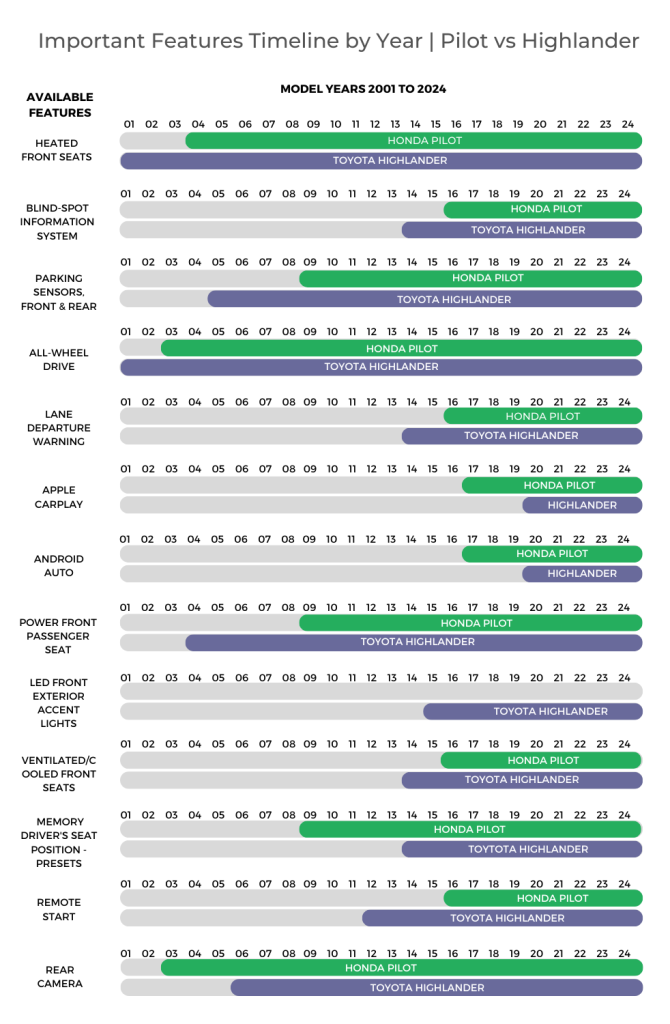
While not a comprehensive breakdown of Pilot and Highlander feature introductions, this chart provides a snapshot of which vehicle got what feature and when. Taking away that the Highlander had a two-year headstart on the Pilot, and based on the specific features highlighted here, Toyota is a clear winner in the contest for releasing new features.
Toyota gets points for offering advanced safety equipment like blind-spot monitoring, lane departure warning, and parking sensors before Honda. However, the Pilot received Apple CarPlay and Android Auto before the Highlander.
Both automakers can split the bragging rights for the initial launch of specific convenience features. The Pilot was the first with a driver’s memory system and rearview camera, while the Highlander gets the honors for remote engine start and a power front passenger seat.
Maintenance Costs (Year-by-Year Average) | Honda Pilot vs Toyota Highlander
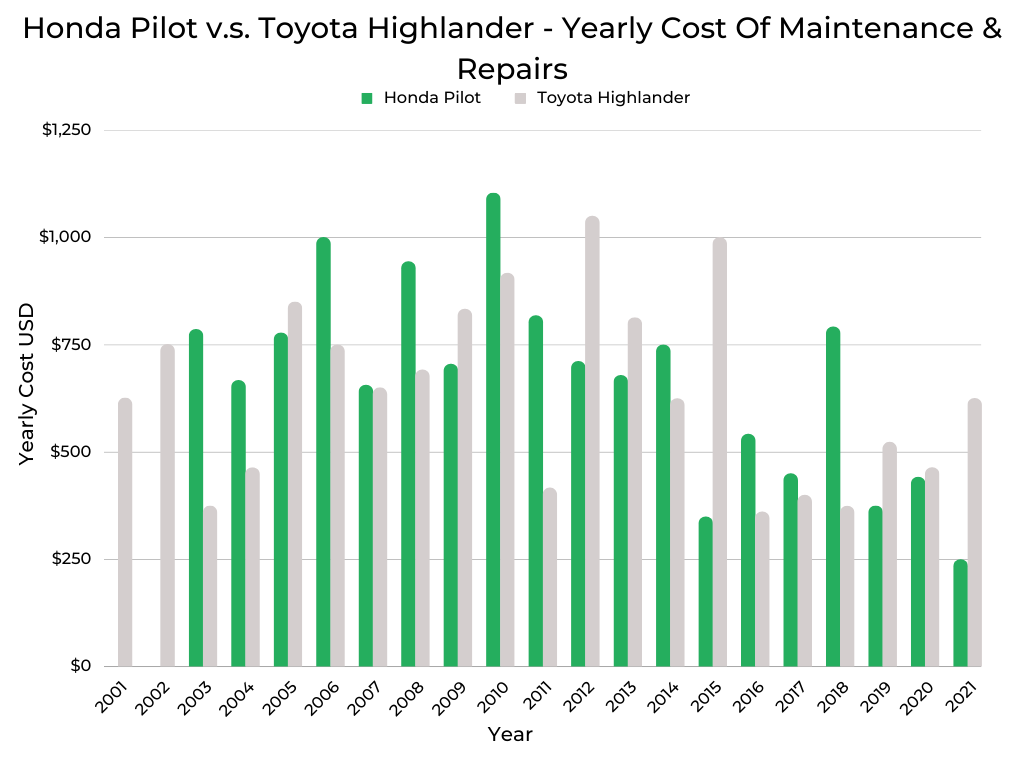
It’s not unusual for maintenance costs to vary between the respective model years for the Honda Pilot and Toyota Highlander. Each vehicle assessed in the FIXD owner surveys is unique. In other words, no two cars are driven or maintained precisely the same way.
However, some Pilots and Highlanders model years have above-average upkeep costs. Specifically, the 2010 Pilot and 2013 Highlander cross the $1,000 threshold, which is well above the yearly averages for all surveyed vehicles ($681 for the Pilot and $646 for the Highlander). The similarity in annual maintenance and repair costs shows another area where these two crossovers are closely matched.
Review the best and worst years of the Honda Pilot and Toyota Highlander to learn more about maintenance and repair costs for these vehicles.
Safety Ratings Comparison | Honda Pilot vs Toyota Highlander
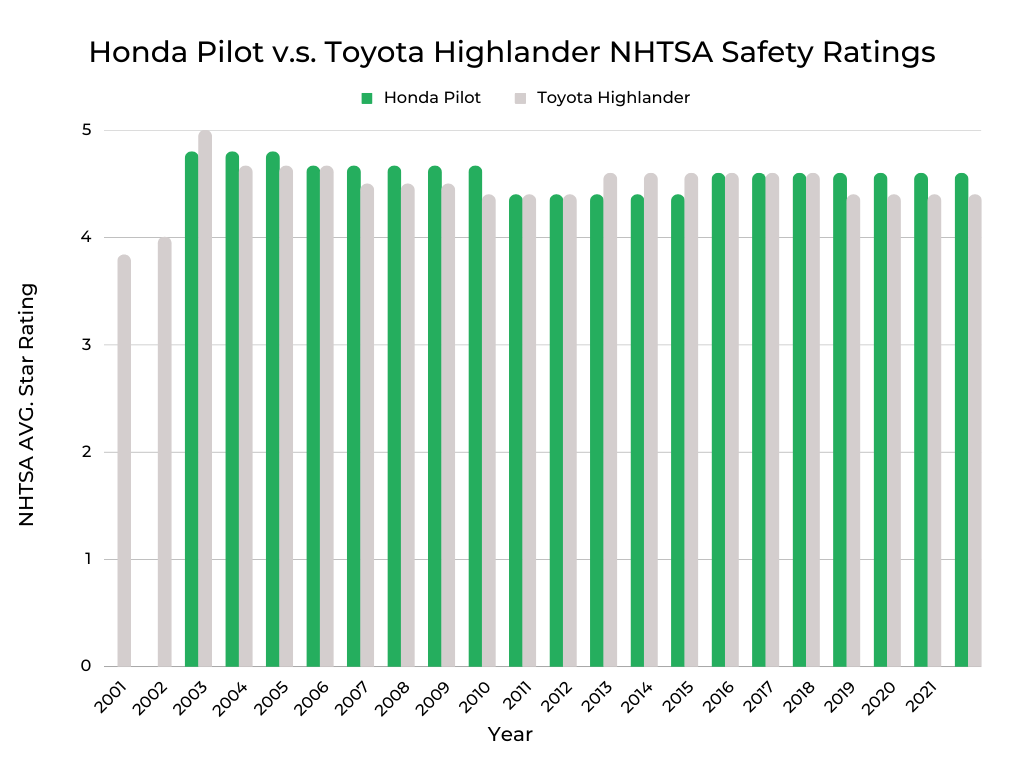
There’s not much to discuss regarding crash test scores and the Honda Pilot and Toyota Highlander. Both vehicles do exceptionally well in NHTSA testing. Any score above 4 (out of 5) is respectable, and these vehicles easily cross this benchmark.
NHTSA made its testing more stringent in 2011, which affected (for the worse) many vehicles in the immediate following years. However, this is basically a non-issue with the Pilot and Highlander, indicating the solid safety engineering that went into designing these family-friendly vehicles.
More details about crash test safety scores are covered in articles about the Honda Pilot and Toyota Highlander.
Fuel Efficiency Comparison | Honda Pilot vs Toyota Highlander
In fairness, we’ve saved the conversation about the Highlander Hybrid for the end of this section. That leaves comparing mileage from conventionally powered Pilots and Highlanders. But there really isn’t a comparison because the Highlander consistently tops the Pilot for best fuel economy. The Honda did manage to equal the Toyota for three years and achieve victory for one year. Otherwise, the Highlander is the fuel economy champion over the Pilot.
Given there’s never been a Pilot hybrid, this part of the discussion focuses solely on the Highlander Hybrid. Toyota has proven that larger cars can still be fuel efficient. Even going back to the early days of the Highlander Hybrid shows that better than 25 MPG was possible with a three-row vehicle. And the numbers only got better, approaching 30 MPG.
Yet, 35 MPG performance with the current generous is especially impressive. Not long ago, this efficiency level was associated with small economy cars.
Hands down, if fuel economy is a priority with a three-row crossover, then the Highlander is the clear choice, regardless of a conventional or hybrid engine.
Methodology
- Compare two vehicles, Honda Pilot and Toyota Highlander, and provide a comprehensive analysis.
- Gather relevant information and data on both vehicles from reliable sources, such as manufacturer specifications, expert reviews, customer feedback, industry reports, and data sources like manufacturer websites, FIXD App, Kelley Blue Book, FuelEconomy.gov, and NHTSA.
- Collect data on various aspects, including performance, safety features, fuel efficiency, maintenance costs, reliability, owner satisfaction, and market value.
- Identify the key criteria that will be used to evaluate and compare the two vehicles.
- Ensure the criteria cover both objective factors (such as performance metrics, safety ratings, and fuel efficiency) and subjective factors (such as owner satisfaction, comfort, and features).
- Assess the performance of both vehicles based on factors such as acceleration, handling, braking, and overall driving experience.
- Compare engine options, horsepower, torque, transmission options, and any unique performance features.
- Examine the safety features and ratings of both vehicles.
- Evaluate crash test ratings, advanced driver assistance systems (ADAS), active and passive safety features, and any notable recalls or known issues related to safety.
- Consider both NHTSA safety ratings and IIHS awards for a comprehensive safety assessment.
- Analyze the fuel economy of both vehicles based on EPA mileage estimates.
- Compare their MPG ratings, average full-tank range, and any significant differences in fuel efficiency.
- Assess the average annual maintenance and repair costs for both vehicles.
- Consider data from surveyed owners and other reliable sources, such as FIXD App owner surveys, to determine the overall cost of ownership over time.
- Evaluate the reliability of both vehicles based on owner reports, FIXD App data, and any known issues or recalls.
- Consider factors such as engine reliability, common problems by model year, long-term durability, and owner reliability scores gathered from surveys.
- Consider owner satisfaction by gathering information from forums, online communities (Reddit: r/whatcarshouldIbuy), customer reviews, and owner reliability scores.
- Summarize key factors that owners appreciate and any common complaints or drawbacks mentioned by owners.
- Compare the features and technologies offered by both vehicles.
- Highlight any notable differences in terms of infotainment systems, connectivity options, driver assistance features, interior quality, and available upgrades.
- Assess the market value and depreciation of both vehicles.
- Compare average prices, resale value, and how the vehicles hold their value over time.
- Consider average private-seller valuations from Kelley Blue Book (KBB) for a comprehensive assessment.
- Summarize the findings of the comparison, highlighting the positives and negatives of each vehicle.
- Provide a fair and balanced recommendation based on the comparison, considering factors such as budget, personal preferences, specific needs of the buyer, and the comprehensive analysis conducted.
Sources:
- KBB Values: Average private-seller valuations as supplied by Kelley Blue Book (KBB), based on a Chevrolet Equinox with typical mileage for that respective model year.
- Fuel Economy: Mileage-per-gallon estimates according to the EPA MPG on Fueleconomy.gov.
- Annual Maintenance/Repairs: Upkeep expenses as reported by surveyed Chevrolet Equinox owners.
- Safety Ratings: Crash test data collected and reported by NHTSA. We average all ratings for each year to come up with a simplified, average safety score. This makes it easier to look at on a graph. We also collected IIHS Awards for this article.
- Vehicle Features: Most or all information gathered on vehicle features were from the manufacturer websites, in this case Hondacars.com and Toyota.com.

Dave Goldberg is an automotive journalist and lifelong car fanatic. He writes for numerous enthusiast and business outlets and is an ongoing contributor to HotCars.com, one of the most popular car culture websites. When he’s not writing or driving, Dave is either under a hood or asleep. His credentials include a BA in Journalism from The George Washington University.

